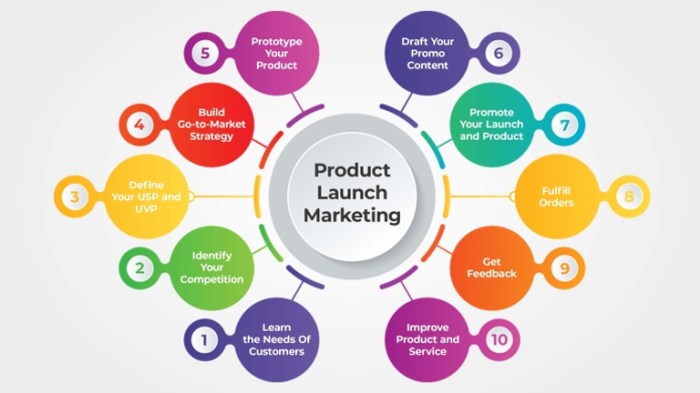Launching Product Campaigns sets the stage for business growth and success. From planning strategies to measuring success, this guide dives deep into the world of product campaigns with a fresh and engaging twist.
Get ready to explore the ins and outs of creating impactful campaigns that resonate with your audience and drive results.
Importance of Launching Product Campaigns
Launching product campaigns is essential for any business looking to increase brand awareness, attract new customers, and boost sales. By effectively promoting a new product or service, companies can generate excitement and interest among their target audience, leading to increased revenue and market share.
Benefits of Launching Product Campaigns
- Increased brand visibility: Well-executed product campaigns can help a brand stand out in a crowded marketplace, making it easier for consumers to remember and recognize the product.
- Customer engagement: Engaging campaigns can create a buzz around a product, encouraging customers to interact with the brand and share their experiences with others.
- Sales growth: Successful product campaigns can drive sales by convincing consumers to try the product and make a purchase.
Examples of Successful Product Campaigns
- Apple’s “Get a Mac” campaign: This series of ads featuring actors playing a Mac and a PC helped Apple differentiate itself from competitors and reinforce its brand image as innovative and user-friendly.
- Coca-Cola’s “Share a Coke”: By personalizing their bottles with popular names, Coca-Cola encouraged customers to share a Coke with friends and family, leading to increased sales and social media engagement.
- Nike’s “Just Do It”: This iconic campaign inspired athletes and consumers to push their limits and pursue their goals, solidifying Nike’s position as a leader in the sports apparel industry.
Planning a Product Campaign Strategy

When it comes to planning a product campaign strategy, there are several key steps that need to be considered in order to ensure its success.
Market Research Importance
Market research plays a crucial role in shaping a campaign strategy as it provides valuable insights into the target audience, their preferences, behaviors, and the overall market landscape. By conducting thorough market research, businesses can better understand their customers and competitors, allowing them to tailor their campaign strategy accordingly.
Setting Specific Goals
Setting specific goals and objectives for a product campaign is essential in order to measure its success and effectiveness. These goals should be clear, achievable, and aligned with the overall business objectives. By setting specific goals, businesses can track their progress and make necessary adjustments to the campaign strategy along the way.
Designing Engaging Campaign Content: Launching Product Campaigns

Crafting compelling content for product campaigns is essential to capture the attention of your target audience and drive engagement. It involves creating content that resonates with your audience, tells a story, and aligns with their preferences.
The Importance of Storytelling, Launching Product Campaigns
Storytelling plays a crucial role in campaign content as it helps to create an emotional connection with your audience. By weaving a narrative around your product or brand, you can engage customers on a deeper level and leave a lasting impression. Utilize storytelling techniques to communicate the value of your product in a way that is relatable and memorable.
Tips for Aligning Content with Audience Preferences
– Conduct thorough research to understand your target audience’s demographics, interests, and behaviors.
– Tailor your content to resonate with the preferences and values of your audience.
– Use language, tone, and visuals that appeal to your audience’s sensibilities.
– Incorporate user-generated content or testimonials to build trust and credibility.
– Utilize interactive elements such as polls, quizzes, or contests to engage your audience.
– Continuously monitor and analyze the performance of your content to optimize for maximum impact.
Choosing the Right Channels for Promotion
When it comes to promoting product campaigns, selecting the right channels is crucial for reaching your target audience effectively and maximizing your campaign’s success. Different marketing channels offer unique advantages and can help you achieve specific campaign goals.
Comparing Different Marketing Channels
- Social Media: Platforms like Instagram, Facebook, and Twitter are great for engaging with a large audience and building brand awareness.
- Email Marketing: Sending targeted emails to potential customers can help drive conversions and build customer loyalty.
- Search Engine Marketing: Using Google Ads or Bing Ads can help increase visibility and drive traffic to your product campaign.
- Influencer Marketing: Partnering with influencers in your industry can help reach a wider audience and build credibility for your product.
Factors to Consider in Selecting Channels
- Target Audience: Choose channels where your target audience is most active to ensure maximum reach and engagement.
- Campaign Goals: Consider the specific goals of your product campaign and select channels that align with those objectives.
- Budget: Evaluate the costs associated with each channel and choose ones that provide the best return on investment for your campaign.
- Channel Effectiveness: Analyze the performance of each channel based on past campaigns or industry benchmarks to determine which ones are most effective for your product.
Successful Cross-Channel Promotion Strategies
One successful strategy is to combine social media advertising with email marketing to create a cohesive campaign that targets both new and existing customers.
Another example is using influencer marketing in conjunction with search engine marketing to increase brand visibility and drive traffic to your product website.
Measuring Campaign Success
To determine the effectiveness of product campaigns, it is crucial to identify key metrics that can provide valuable insights into the performance of the campaign. Analyzing data and performance indicators allows marketers to make informed decisions and optimize strategies for better results.
Key Metrics for Measuring Campaign Success
- Conversion Rate: Measure the percentage of users who took a desired action, such as making a purchase or signing up for a newsletter, as a result of the campaign.
- ROI (Return on Investment): Calculate the return on investment to determine if the campaign generated more revenue than the cost of running it.
- Engagement Metrics: Monitor metrics like click-through rates, time spent on site, and social media interactions to gauge the level of engagement with the campaign.
- Sales Revenue: Track the increase in sales revenue during and after the campaign to assess its impact on driving conversions.
Significance of Analyzing Data and Performance Indicators
Analyzing data and performance indicators provides valuable insights into what is working and what is not in a product campaign. It helps marketers understand the effectiveness of their strategies, identify areas for improvement, and make data-driven decisions to optimize future campaigns.
Adjusting Strategies Based on Campaign Performance Data
By closely monitoring campaign performance data, marketers can identify patterns, trends, and areas of improvement. This allows them to adjust their strategies in real-time, make necessary tweaks to optimize performance, and ensure that the campaign is on track to meet its goals.












